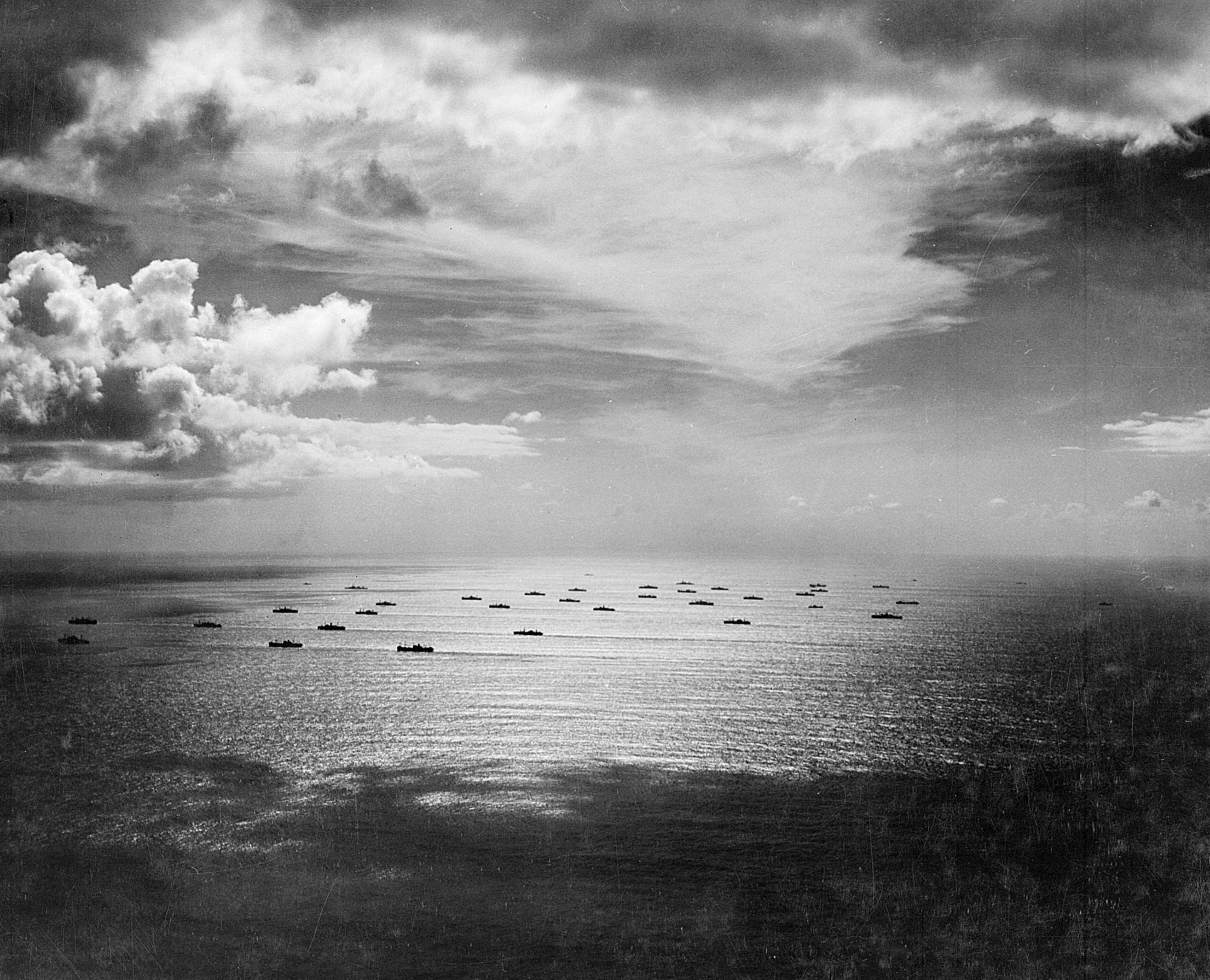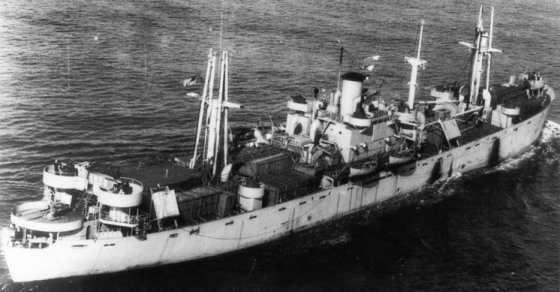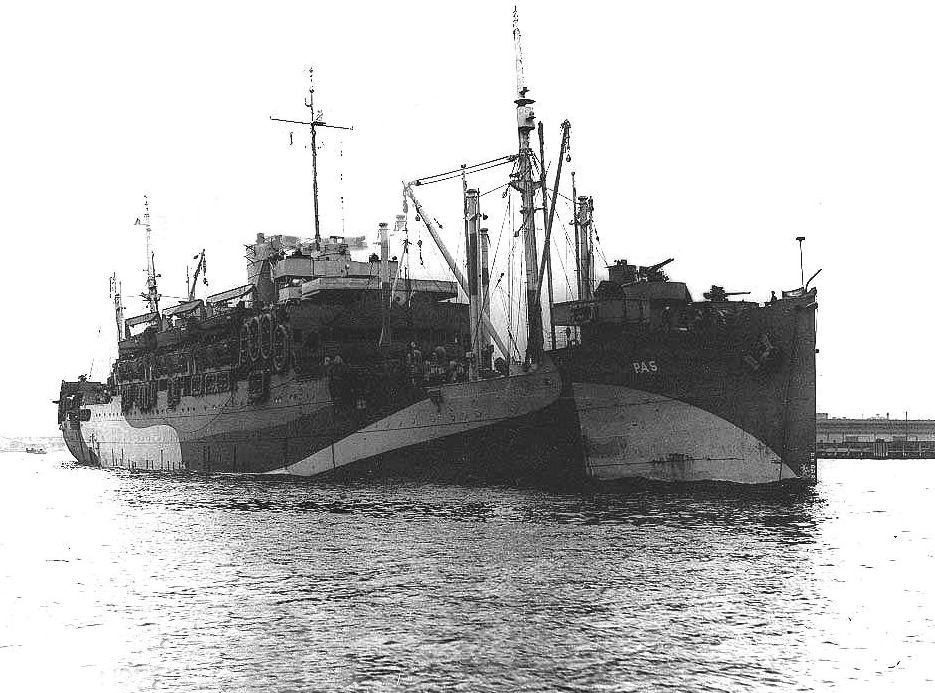UG convoys on:
[Wikipedia]
[Google]
[Amazon]
 The UG convoys were a series of east-bound trans-
The UG convoys were a series of east-bound trans-
 Commencing with UGF 2, sailing New York 6 November 1942, fast eastbound convoys were sailed along the southern trans-Atlantic route at irregular intervals of about 25 days until June 1943. Convoys UGF 2 and UGF 3 terminated in Casablanca, and the termination point was extended into the Mediterranean port of Oran with convoy UGF 4. In preparation for the
Commencing with UGF 2, sailing New York 6 November 1942, fast eastbound convoys were sailed along the southern trans-Atlantic route at irregular intervals of about 25 days until June 1943. Convoys UGF 2 and UGF 3 terminated in Casablanca, and the termination point was extended into the Mediterranean port of Oran with convoy UGF 4. In preparation for the
 * ''U-73'' torpedoed Liberty Ship ''Arthur Middleton'' in convoy UGS 3 on 1 January 1943.
* ''U-565'' torpedoed the American freighter ''Michigan'' and the French troopship ''Sidi-bel-Abbes'' in convoy UGS 7 on 20 April 1943.
* ''U-572'' torpedoed the French tanker ''Lot'' in convoy UGS 10 on 22 June 1943.
* British freighter in convoy UGS 13 was sunk by aircraft on 16 August 1943.
* ''U-410'' torpedoed Liberty Ships ''John Bell'' and ''Richard Henderson'' in convoy UGS 14 on 26 August 1943.
* ''U-410'' torpedoed Liberty Ship ''Christian Michelson'' in convoy UGS 17 on 26 September 1943.
* British freighter ''Fort Fitzgerald'' in convoy UGS 18 was sunk by aircraft on 4 October 1943.
* Liberty Ship ''Edward Bates'' in convoy UGS 30 was sunk by aircraft on 1 February 1944.
* Liberty Ships ''Virginia Dare'' and '' Daniel Chester French'' were sunk when convoy UGS 33 entered an Allied minefield on 6 March 1944.
* ''U-407'' torpedoed Liberty Ships ''Meyer London'' and ''Thomas G. Masaryk'' in convoy UGS 37 on 16 April 1944.
* Liberty Ship ''Paul Hamilton'' and British freighter ''Royal Star'' in convoy UGS 38 were sunk by aircraft on 20 April 1944.
* ''U-300'' torpedoed British tanker ''Regent Lion'' in convoy UGS 72 on 17 February 1945.
* ''U-73'' torpedoed Liberty Ship ''Arthur Middleton'' in convoy UGS 3 on 1 January 1943.
* ''U-565'' torpedoed the American freighter ''Michigan'' and the French troopship ''Sidi-bel-Abbes'' in convoy UGS 7 on 20 April 1943.
* ''U-572'' torpedoed the French tanker ''Lot'' in convoy UGS 10 on 22 June 1943.
* British freighter in convoy UGS 13 was sunk by aircraft on 16 August 1943.
* ''U-410'' torpedoed Liberty Ships ''John Bell'' and ''Richard Henderson'' in convoy UGS 14 on 26 August 1943.
* ''U-410'' torpedoed Liberty Ship ''Christian Michelson'' in convoy UGS 17 on 26 September 1943.
* British freighter ''Fort Fitzgerald'' in convoy UGS 18 was sunk by aircraft on 4 October 1943.
* Liberty Ship ''Edward Bates'' in convoy UGS 30 was sunk by aircraft on 1 February 1944.
* Liberty Ships ''Virginia Dare'' and '' Daniel Chester French'' were sunk when convoy UGS 33 entered an Allied minefield on 6 March 1944.
* ''U-407'' torpedoed Liberty Ships ''Meyer London'' and ''Thomas G. Masaryk'' in convoy UGS 37 on 16 April 1944.
* Liberty Ship ''Paul Hamilton'' and British freighter ''Royal Star'' in convoy UGS 38 were sunk by aircraft on 20 April 1944.
* ''U-300'' torpedoed British tanker ''Regent Lion'' in convoy UGS 72 on 17 February 1945.
 The United States Navy provided all escorts between Hampton Roads and Gibraltar, although some of the
The United States Navy provided all escorts between Hampton Roads and Gibraltar, although some of the
 The UG convoys were a series of east-bound trans-
The UG convoys were a series of east-bound trans-Atlantic
The Atlantic Ocean is the second-largest of the world's five oceans, with an area of about . It covers approximately 20% of Earth's surface and about 29% of its water surface area. It is known to separate the " Old World" of Africa, Europe an ...
convoy
A convoy is a group of vehicles, typically motor vehicles or ships, traveling together for mutual support and protection. Often, a convoy is organized with armed defensive support and can help maintain cohesion within a unit. It may also be used ...
s from the United States to Gibraltar carrying food, ammunition, and military hardware to the United States Army
The United States Army (USA) is the land warfare, land military branch, service branch of the United States Armed Forces. It is one of the eight Uniformed services of the United States, U.S. uniformed services, and is designated as the Army o ...
in North Africa
Africa is the world's second-largest and second-most populous continent, after Asia in both cases. At about 30.3 million km2 (11.7 million square miles) including adjacent islands, it covers 6% of Earth's total surface area ...
and southern Europe
Europe is a large peninsula conventionally considered a continent in its own right because of its great physical size and the weight of its history and traditions. Europe is also considered a subcontinent of Eurasia and it is located entirel ...
during World War II
World War II or the Second World War, often abbreviated as WWII or WW2, was a world war that lasted from 1939 to 1945. It involved the vast majority of the world's countries—including all of the great powers—forming two opposing ...
. These convoys assembled in Hampton Roads near the mouth of Chesapeake Bay
The Chesapeake Bay ( ) is the largest estuary in the United States. The Bay is located in the Mid-Atlantic region and is primarily separated from the Atlantic Ocean by the Delmarva Peninsula (including the parts: the Eastern Shore of Maryland / ...
and terminated in various North African locations as Axis
An axis (plural ''axes'') is an imaginary line around which an object rotates or is symmetrical. Axis may also refer to:
Mathematics
* Axis of rotation: see rotation around a fixed axis
* Axis (mathematics), a designator for a Cartesian-coordinat ...
forces retreated from 1942 through 1945.Hague, Arnold ''The Allied Convoy System 1939–1945'' Naval Institute Press 2000 pp.179-183

Background
Allied war materials had been transported from North America to theBritish Isles
The British Isles are a group of islands in the North Atlantic Ocean off the north-western coast of continental Europe, consisting of the islands of Great Britain, Ireland, the Isle of Man, the Inner and Outer Hebrides, the Northern Isles, ...
in HX convoys since 1939 and in slower SC convoys since 1940. These convoys were escorted by the Royal Navy
The Royal Navy (RN) is the United Kingdom's naval warfare force. Although warships were used by English and Scottish kings from the early medieval period, the first major maritime engagements were fought in the Hundred Years' War against ...
and Royal Canadian Navy
The Royal Canadian Navy (RCN; french: Marine royale canadienne, ''MRC'') is the naval force of Canada. The RCN is one of three environmental commands within the Canadian Armed Forces. As of 2021, the RCN operates 12 frigates, four attack submar ...
. The United States Navy
The United States Navy (USN) is the maritime service branch of the United States Armed Forces and one of the eight uniformed services of the United States. It is the largest and most powerful navy in the world, with the estimated tonnage ...
provided a few escorts to HX and SC convoys from September 1941 through April 1943. UG convoys were established as a second, more direct, supply route to support the invasion of North Africa. The first convoy, designated UGF 1, was the invasion convoy sailing on 24 October 1942 and arriving on 8 November 1942. The F designated a convoy of faster ships. Thereafter, fast and slow eastbound and westbound convoys on this southern route were given four separate numbering sequences beginning with 2.
Fast eastbound convoys designated UGF
 Commencing with UGF 2, sailing New York 6 November 1942, fast eastbound convoys were sailed along the southern trans-Atlantic route at irregular intervals of about 25 days until June 1943. Convoys UGF 2 and UGF 3 terminated in Casablanca, and the termination point was extended into the Mediterranean port of Oran with convoy UGF 4. In preparation for the
Commencing with UGF 2, sailing New York 6 November 1942, fast eastbound convoys were sailed along the southern trans-Atlantic route at irregular intervals of about 25 days until June 1943. Convoys UGF 2 and UGF 3 terminated in Casablanca, and the termination point was extended into the Mediterranean port of Oran with convoy UGF 4. In preparation for the Allied invasion of Sicily
The Allied invasion of Sicily, also known as Operation Husky, was a major campaign of World War II in which the Allied forces invaded the island of Sicily in July 1943 and took it from the Axis powers ( Fascist Italy and Nazi Germany). It b ...
, convoys UGF 8 and UGF 9 sailed in two sections with the second section being identified as UGF 8A and UGF 9A, respectively. Sailing frequency to the Mediterranean was then reduced by preparations for Operation Overlord. Convoy UGF 10 was the last convoy terminating at Oran on 2 September 1943; and convoy UGF 11 was the first reaching the southern European port of Naples
Naples (; it, Napoli ; nap, Napule ), from grc, Νεάπολις, Neápolis, lit=new city. is the regional capital of Campania and the third-largest city of Italy, after Rome and Milan, with a population of 909,048 within the city's adminis ...
on 31 May 1944. With UGF 12 sailing Hampton Roads 1 July 1944, the interval was set at 27 days, at which it remained the rest of the war. This schedule called for two escort groups based at Norfolk and two convoy commodores. Separate convoys designated UGF 15B and UGF 17B terminated in Marseilles. The last fast eastbound convoy UGF 22 terminated in Oran on 8 April 1945. A total of 382 ships sailed in 26 fast convoys, and none were lost.
Slow eastbound convoys designated UGS
Approximately two slow eastbound convoys per month departed Hampton Roads along the southern trans-Atlantic route beginning with convoy UGS 2 on 13 November 1942. Frequency of sailing increased to three convoys per month in the summer of 1943 and increased again to six convoys per month in 1945. The last slow eastbound convoy, UGS 95, left Hampton Roads on 28 May 1945. Approximately 5800 ships sailed in 100 slow convoys. Additional sections were identified as UGS 5A, UGS 6A, UGS 7A, UGS 8A, UGS 33A, and UGS 55B. Convoy UGS 6 came under attack by wolf packs ''Unverzagt'', ''Wohlgemut'', and ''Tummler'' during the submarine offensive including the battle of convoys HX 229/SC 122. Three ships were sunk:Hague, Arnold ''The Allied Convoy System 1939–1945'' Naval Institute Press 2000 p.181 * ''U-524'' torpedoed the French freighter ''Wyoming'' on 15 March 1943. * ''U-172'' torpedoed theLiberty Ship
Liberty ships were a class of cargo ship built in the United States during World War II under the Emergency Shipbuilding Program. Though British in concept, the design was adopted by the United States for its simple, low-cost construction. Ma ...
''Benjamin Harrison'' on 16 March 1943.
* ''U-167'' and ''U-521'' torpedoed the Liberty Ship ''Molly Pitcher'' on 17 March 1943.
These were the only ships lost during the Atlantic crossing of these convoys, although the following ships were lost in the Mediterranean Sea
The Mediterranean Sea is a sea connected to the Atlantic Ocean, surrounded by the Mediterranean Basin and almost completely enclosed by land: on the north by Western and Southern Europe and Anatolia, on the south by North Africa, and on the ...
:
 * ''U-73'' torpedoed Liberty Ship ''Arthur Middleton'' in convoy UGS 3 on 1 January 1943.
* ''U-565'' torpedoed the American freighter ''Michigan'' and the French troopship ''Sidi-bel-Abbes'' in convoy UGS 7 on 20 April 1943.
* ''U-572'' torpedoed the French tanker ''Lot'' in convoy UGS 10 on 22 June 1943.
* British freighter in convoy UGS 13 was sunk by aircraft on 16 August 1943.
* ''U-410'' torpedoed Liberty Ships ''John Bell'' and ''Richard Henderson'' in convoy UGS 14 on 26 August 1943.
* ''U-410'' torpedoed Liberty Ship ''Christian Michelson'' in convoy UGS 17 on 26 September 1943.
* British freighter ''Fort Fitzgerald'' in convoy UGS 18 was sunk by aircraft on 4 October 1943.
* Liberty Ship ''Edward Bates'' in convoy UGS 30 was sunk by aircraft on 1 February 1944.
* Liberty Ships ''Virginia Dare'' and '' Daniel Chester French'' were sunk when convoy UGS 33 entered an Allied minefield on 6 March 1944.
* ''U-407'' torpedoed Liberty Ships ''Meyer London'' and ''Thomas G. Masaryk'' in convoy UGS 37 on 16 April 1944.
* Liberty Ship ''Paul Hamilton'' and British freighter ''Royal Star'' in convoy UGS 38 were sunk by aircraft on 20 April 1944.
* ''U-300'' torpedoed British tanker ''Regent Lion'' in convoy UGS 72 on 17 February 1945.
* ''U-73'' torpedoed Liberty Ship ''Arthur Middleton'' in convoy UGS 3 on 1 January 1943.
* ''U-565'' torpedoed the American freighter ''Michigan'' and the French troopship ''Sidi-bel-Abbes'' in convoy UGS 7 on 20 April 1943.
* ''U-572'' torpedoed the French tanker ''Lot'' in convoy UGS 10 on 22 June 1943.
* British freighter in convoy UGS 13 was sunk by aircraft on 16 August 1943.
* ''U-410'' torpedoed Liberty Ships ''John Bell'' and ''Richard Henderson'' in convoy UGS 14 on 26 August 1943.
* ''U-410'' torpedoed Liberty Ship ''Christian Michelson'' in convoy UGS 17 on 26 September 1943.
* British freighter ''Fort Fitzgerald'' in convoy UGS 18 was sunk by aircraft on 4 October 1943.
* Liberty Ship ''Edward Bates'' in convoy UGS 30 was sunk by aircraft on 1 February 1944.
* Liberty Ships ''Virginia Dare'' and '' Daniel Chester French'' were sunk when convoy UGS 33 entered an Allied minefield on 6 March 1944.
* ''U-407'' torpedoed Liberty Ships ''Meyer London'' and ''Thomas G. Masaryk'' in convoy UGS 37 on 16 April 1944.
* Liberty Ship ''Paul Hamilton'' and British freighter ''Royal Star'' in convoy UGS 38 were sunk by aircraft on 20 April 1944.
* ''U-300'' torpedoed British tanker ''Regent Lion'' in convoy UGS 72 on 17 February 1945.
Fast westbound convoys designated GUF
A total of 335 ships returned to the United States along the southern trans-Atlantic route in 24 fast convoys beginning with the sailing of convoy GUF 2 from Casablanca on 29 November 1942. The last fast westbound convoy GUF 22 left Oran on 16 April 1945. Additional sections were identified as GUF 2A, GUF 15B, and GUF 17B. No ships were lost from these fast convoys.Slow westbound convoys designated GUS
Approximately 5200 ships returned to the United States along the southern trans-Atlantic route in 98 slow convoys beginning with the sailing of convoy GUS 2 from Oran on 21 December 1942. The last slow westbound convoy GUS 92 left Oran on 27 May 1945. Additional sections were identified as GUS 5A, GUS 5B, GUS 6A, GUS 7A, GUS 8A, GUS 10X, and GUS 55B. There were no losses from these convoys during the Atlantic portion of their voyage, but five ships were lost within the Mediterranean Sea: * ''U-371'' torpedoed the Liberty Ship ''James Russell Lowell'' in convoy GUS 18 on 15 October 1943.Cressman, Robert J. ''The Official Chronology of the U. S. Navy in World War II'' Naval Institute Press 2000 p.181 * British freighter ''Alpherat'' in convoy GUS 25 was sunk by aircraft on 21 December 1943.Hague, Arnold ''The Allied Convoy System 1939–1945'' Naval Institute Press 2000 p.183 * ''U-969'' torpedoed the Liberty Ships ''George Cleeve'' and ''Peter Skene Ogden'' in convoy GUS 31 on 22 February 1944.Cressman, Robert J. ''The Official Chronology of the U. S. Navy in World War II'' Naval Institute Press 2000 p.214 * ''U-870'' torpedoed the Liberty Ship ''Henry Miller'' in convoy GUS 63 on 3 January 1945.Cressman, Robert J. ''The Official Chronology of the U. S. Navy in World War II'' Naval Institute Press 2000 p.286Escorts
 The United States Navy provided all escorts between Hampton Roads and Gibraltar, although some of the
The United States Navy provided all escorts between Hampton Roads and Gibraltar, although some of the destroyer escort
Destroyer escort (DE) was the United States Navy mid-20th-century classification for a warship designed with the endurance necessary to escort mid-ocean convoys of merchant marine ships.
Development of the destroyer escort was promoted by th ...
s providing anti-submarine screens for these convoys had United States Coast Guard
The United States Coast Guard (USCG) is the maritime security, search and rescue, and law enforcement service branch of the United States Armed Forces and one of the country's eight uniformed services. The service is a maritime, military, mu ...
crews. A typical screen was provided by an escort division (CortDiv) of six destroyer escorts.Franklin, Bruce Hampton (1999) ''The Buckley-class Destroyer Escorts'' Naval Institute Press pp.192-195 Most of these convoys were given air coverage from escort carriers and patrol bombers flying from the Azores
)
, motto =( en, "Rather die free than subjected in peace")
, anthem= ( en, "Anthem of the Azores")
, image_map=Locator_map_of_Azores_in_EU.svg
, map_alt=Location of the Azores within the European Union
, map_caption=Location of the Azores wi ...
. The Royal Navy initially provided escorts within the Mediterranean, although United States escorted these convoys as far as Oran as the front moved east.
See also
Notes
References
* * Arnold Hague : The Allied Convoy System 1939–1945 (2000). ISBN (Canada) 1 55125 033 0 . ISBN (UK) 1 86176 147 3 * * {{cite book, title=U.S. Warships of World War II , author=Silverstone, Paul H. , publisher=Doubleday and Company , year=1968 North Atlantic convoys of World War II Battle of the Atlantic